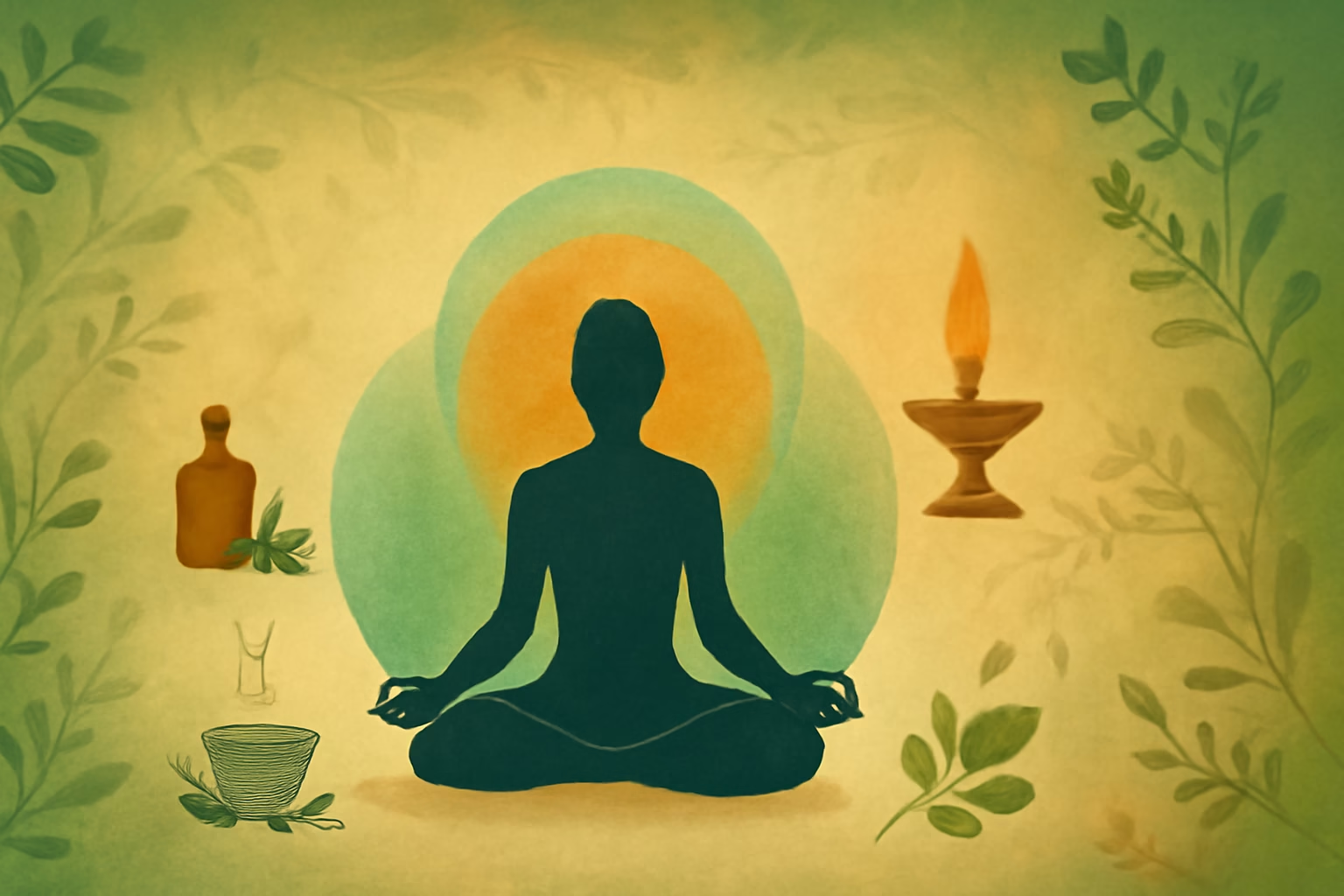
Prakruti in Ayurveda, the ancient system of medicine that originated in India, has been practiced for over 5,000 years.
One of the core concepts of Ayurveda is “Prakruti,” which refers to an individual’s unique constitution.
According to Ayurvedic philosophy, each person is born with a specific combination of the three doshas – Vata, Pitta, and Kapha – which influence their physical, mental, and emotional characteristics.
Understanding your Prakruti can help you achieve a state of balance, optimize your health, and prevent diseases.
In this blog, we will explore the concept of Prakruti in Ayurveda, its significance, how it relates to the doshas, and the benefits of knowing your Prakruti.
Understanding Prakruti
In Ayurveda, Prakruti refers to the inherent nature or constitution of an individual, which is determined at the time of conception.
It is the unique combination of the three doshas (Vata, Pitta, and Kapha) that shape a person’s physical attributes, temperament, and susceptibility to certain health conditions.
Prakruti is not something that changes over time; it remains constant throughout life, although external factors like diet, lifestyle, and environment can influence the balance of the doshas within your body.
Prakruti is deeply linked to the concept of the five elements (earth, water, fire, air, and ether), which are the building blocks of the doshas.
Each dosha is composed of two of these five elements, and their proportions in your body determine your Prakruti.
Vata is made up of air and ether, Pitta is made up of fire and water, and Kapha is made up of earth and water.
Understanding your Prakruti is crucial for tailoring your diet, lifestyle, and health practices to maintain balance.
Ayurveda teaches that when the doshas are in harmony, the body and mind are in optimal health.
However, when they are out of balance, it can lead to illness and disease. By understanding your Prakruti, you can take steps to maintain balance and prevent disorders associated with an imbalanced dosha.
Types of Prakruti in Ayurveda
Ayurveda identifies three primary types of Prakruti, which correspond to the three doshas: Vata, Pitta, and Kapha.
These types are further classified based on the dominance of the doshas in a person’s constitution.
The types of Prakruti are as follows:
Vata Prakruti
Individuals with a dominant Vata Prakruti are characterized by qualities such as lightness, dryness, coldness, and movement.
They tend to be thin, with a delicate build, dry skin, and quick movements. They are often energetic and creative but can also be prone to anxiety and restlessness.
Vata types are more susceptible to conditions related to dryness, such as joint pain, constipation, and nervous system disorders.
Pitta Prakruti
Pitta Prakruti is associated with qualities like heat, sharpness, intensity, and fluidity.
People with a dominant Pitta dosha tend to have a medium build, warm body temperature, and strong digestion.
They are often ambitious, focused, and driven, but they can also be prone to irritability, anger, and digestive issues such as acid reflux.
Pitta types are more likely to experience conditions related to inflammation, such as skin rashes, ulcers, and high blood pressure.
Kapha Prakruti
Kapha Prakruti is characterized by qualities of heaviness, stability, moisture, and coolness.
Individuals with a dominant Kapha dosha are typically robust, with a strong build, smooth skin, and a calm, grounded demeanor.
They are naturally nurturing and tend to have good endurance, but they can be prone to lethargy, weight gain, and conditions like allergies, respiratory problems, and diabetes.
In addition to these primary dosha types, there are combinations of doshas that result in unique Prakruti profiles.
Let’s take a closer look at the combinations of Vata, Pitta, and Kapha.
Vata Pitta Kapha Prakruti
Some individuals have a combination of two or more doshas, which influences their constitution.
A Vata Pitta Kapha Prakruti, for example, is a blend of all three doshas. People with this Prakruti have qualities of both Vata’s movement and dryness, Pitta’s heat and intensity, and Kapha’s stability and moisture.
This combination results in a complex constitution with a balance of energies. These individuals may be energetic and creative but also prone to emotional extremes and digestive issues.
If you want to learn more about Vatta, Pitta and Kapha in hindi, you can check out my other article Vat Pit Kaf Kya Hai? Ayurveda Mein Tridosha Ko Samjhiye.
Importance of Knowing Your Prakruti
Knowing your Prakruti is essential for maintaining overall well-being. It serves as a roadmap for understanding your body’s natural tendencies, strengths, and weaknesses.
Once you are aware of your Prakruti, you can make more informed decisions about your diet, exercise, sleep patterns, and lifestyle choices.
Here are some key reasons why understanding your Prakruti is important:
- Tailored Health Practices: By knowing your Prakruti, you can adopt a lifestyle that is aligned with your unique constitution. For example, Vata types may benefit from warm, grounding foods, while Pitta types may need cooling foods to prevent overheating.
- Prevention of Illness: Ayurveda emphasizes the importance of prevention. By balancing your doshas and following practices that support your Prakruti, you can prevent the onset of diseases and maintain a healthy body and mind.
- Emotional Well-being: Your Prakruti not only influences your physical health but also your mental and emotional state. By understanding your Prakruti, you can better manage stress, anxiety, and emotional challenges.
- Personalized Treatment: If you do fall ill, knowing your Prakruti can guide you toward more effective and personalized treatments. Ayurvedic practitioners can recommend herbs, oils, and therapies tailored to your constitution.
Determining Your Prakruti
Determining your Prakruti involves assessing the qualities of the three doshas within your body.
Ayurvedic practitioners typically use questionnaires, pulse diagnosis, and physical examination to identify your dosha dominance.
These methods assess your physical characteristics, personality traits, digestion, sleep patterns, and emotional tendencies.
However, there are simple ways you can begin to understand your Prakruti on your own:
- Physical Characteristics: Observe your body type, skin texture, and energy levels. Do you tend to be thin and energetic (Vata), medium and warm (Pitta), or strong and steady (Kapha)?
- Mental and Emotional Traits: Consider your mental and emotional tendencies. Are you creative and restless (Vata), focused and driven (Pitta), or calm and nurturing (Kapha)?
- Digestion and Sleep: How is your digestion? Do you have a strong appetite and digestion (Pitta), or are you prone to gas and bloating (Vata)? How do you sleep? Do you have deep, restful sleep (Kapha), or do you struggle with insomnia (Vata)?
Once you identify your dominant dosha or combination of doshas, you can use this knowledge to create a personalized plan for achieving balance.
Maintaining Balance and Preventing Diseases

Ayurveda teaches that health is the result of balanced doshas, while imbalance leads to disease.
The key to maintaining balance is following practices that are aligned with your Prakruti.
Here are some general guidelines for maintaining dosha balance:
- Diet: Choose foods that are compatible with your dosha. For example, Vata types should consume warm, moist, and grounding foods, while Pitta types should opt for cooling and refreshing foods.
- Exercise: Engage in activities that suit your Prakruti. Vata types benefit from gentle, grounding exercises like yoga or walking, while Pitta types can handle more intense activities like running or swimming. Kapha types should focus on invigorating exercises that increase circulation.
- Lifestyle: Pay attention to your daily routines. Vata types should prioritize regularity and grounding activities, while Pitta types may benefit from relaxation techniques to calm their intense energy. Kapha types should focus on staying active to prevent stagnation.
- Mindfulness and Meditation: Practices like mindfulness, deep breathing, and meditation can help restore emotional balance and reduce stress.
Prakruti and Natural Healing

Ayurveda emphasizes natural healing methods that are tailored to the individual’s Prakruti.
Herbal remedies, dietary adjustments, detoxification therapies, and Ayurvedic treatments such as Panchakarma can help bring the doshas into balance.
By addressing the root cause of imbalances, Ayurveda promotes long-term healing and wellness.
If you’re interested in learning more about how Ayurveda can help with specific imbalances, check out my blog post on Understanding Tridosha in Ayurveda: A Comprehensive Guide to Balance Your Mind, Body, and Spirit, where we delve deeper into the importance of understanding all three doshas for optimal health.
Personalized Prevention Based on Prakruti
Prevention is a key principle in Ayurveda, and it starts with understanding your Prakruti.
By following a personalized prevention plan based on your dosha, you can avoid potential health issues and lead a balanced life.
Whether you’re looking to prevent digestive issues, emotional imbalances, or chronic diseases, Ayurveda offers practical solutions to keep your doshas in harmony.
To gain more insights on Vata Dosha and its effects on health, check out my post on Mastering Vata Dosha: Your Complete Guide to Well-Being.
It provides in-depth information on the Vata dosha and how it impacts your body and mind.
In conclusion, Prakruti is the foundation of Ayurvedic healing and plays a vital role in determining your overall health and well-being.
By understanding your unique constitution and following the principles of Ayurveda, you can achieve balance, prevent disease, and live a more fulfilling life.
